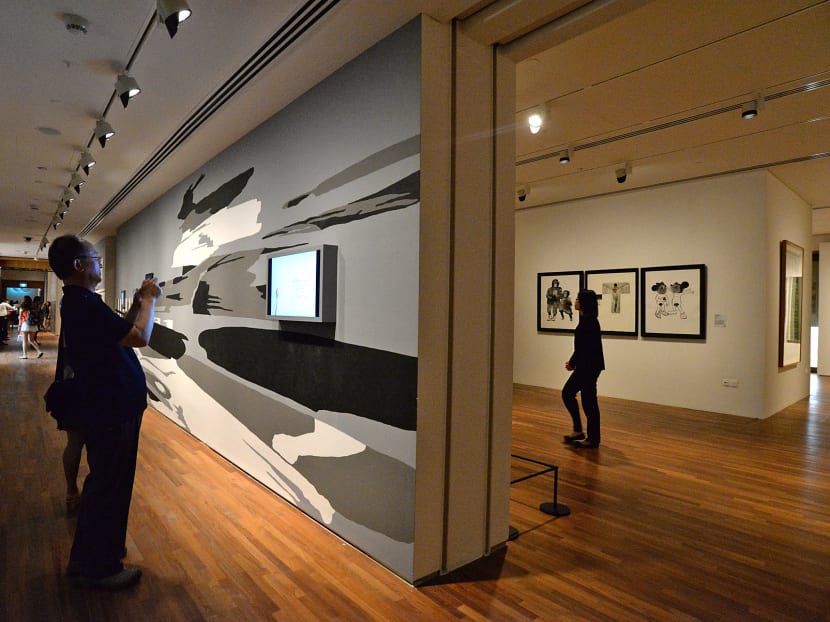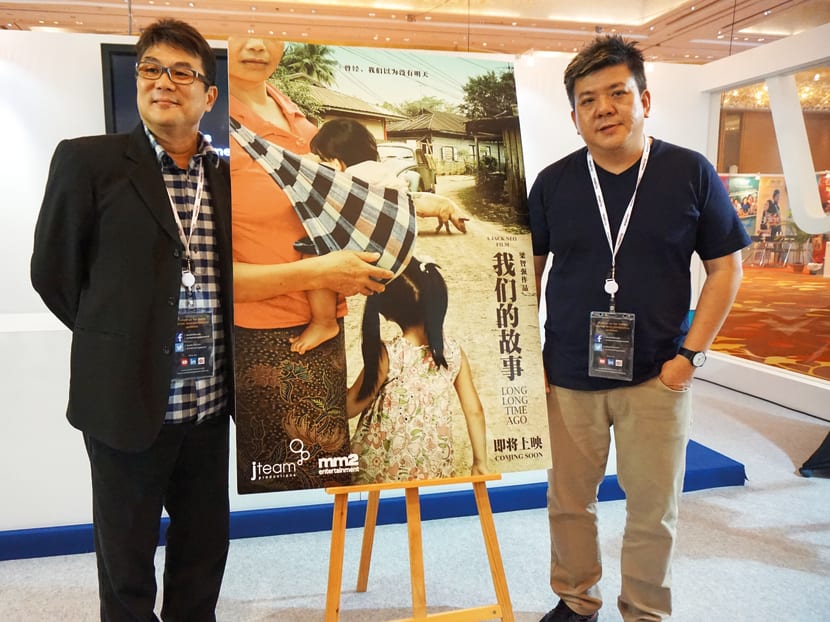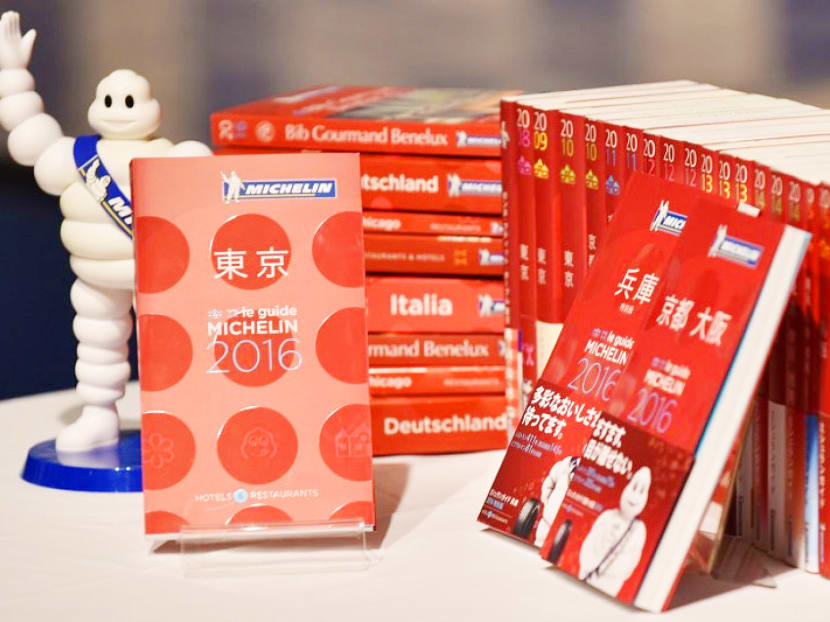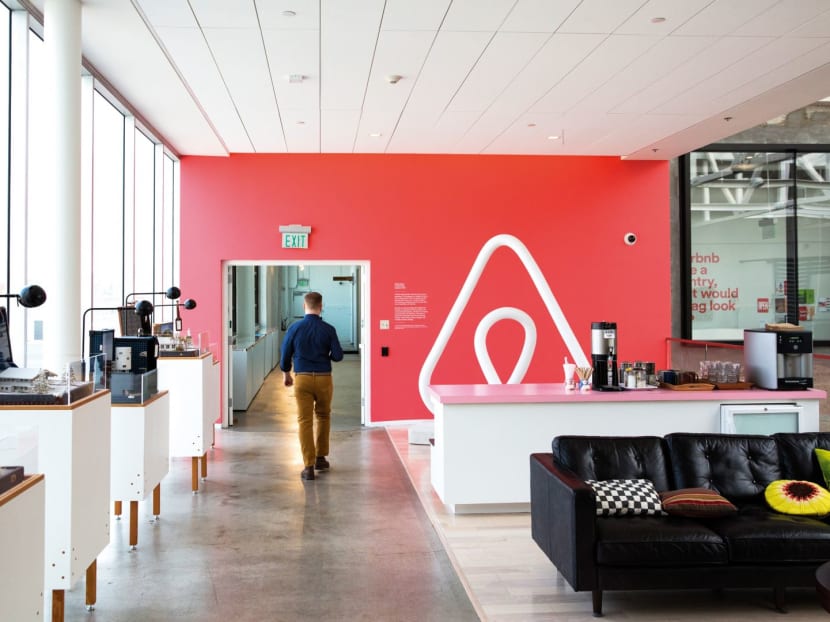Unveiling Singapore's next chapter in entertainment & lifestyle

A light display at the opening ceremony of National Gallery Singapore on Nov 27. Photo: Wee Teck Hian/TODAY
jQuery.noConflict() Unveiling Singapore's next chapter in entertainment & lifestyle
TODAY Features Deskfeatures [at] mediacorp.com.sg Published: Wednesday, 30 December 2015
As this year draws to a close, it is worthwhile looking back at the goings-on that have made a big impact on Singapore’s entertainment and lifestyle scene.
There were countless shows, events and exhibitions that gave a nod to the SG50 celebrations, but the opening of the much-lauded National Gallery Singapore was probably the Big Event that capped an equally big year for the arts. Musicians past and present — from Inch Chua to The Flybaits to The Sam Willows — got to show off their mettle, through music releases (2015 saw a bumper crop of albums and EPs) and performances; while Singapore’s movie-makers were busy with key movies, including the film anthology 7 Letters, musical capers Mr Unbelievable and 3688, and the drama 1965.
Meanwhile, the country’s reputation as a foodie hub got a boost with the Michelin Guide announcing a Singapore edition for next year. Local fare was celebrated, while start-ups upped the ante, even as local chefs and bartenders took top honours on the global stage. In the world of fashion and beauty, there was an established push for local designers to dip their toes in international waters.
In all, it was, as Frank Sinatra once sang, a very good year.
But what of 2016? What can we look forward to? We take a quick peek.

The year-long SG50 celebrations brought about countless shows, events and exhibitions that were linked to the nationwide festivities, indirectly or otherwise. From revivals and restagings of theatre classics, to works tailor-made for SG50 and retrospective exhibitions on the various arts scenes, there was no let-up on an already-packed arts calendar.
“More than ever before, significant resources have been channelled towards creating new work in celebration of our Jubilee year ... it has encouraged a lot of commissions and provided work for artists,” award-winning actress Janice Koh previously told TODAY.
Janice Koh
Local actress“More than ever before, significant resources have been channelled towards creating new work in celebration of our Jubilee year ... it has encouraged a lot of commissions and provided work for artists.”
Running parallel to the arts explosion was the issue of censorship through funding: The National Arts Council (NAC) pulled funding after it deemed the best-selling graphic novel The Art Of Charlie Chan Hock Chye undermined government authority. This led to a heated debate between artists and the council this year.
As theatre director Alvin Tan wondered: Will this have an effect on the type of works coming out next year? And will audiences see “safer” works?
Controversy or not though, arts lovers can expect a busy year ahead. Museum makeovers will continue with the Asian Civilisations Museum opening its Ceramics Gallery and Trade Gallery, and the National Museum of Singapore re-opening its Drum space. Part of its children’s section will also undergo a revamp.
Meanwhile, the Civic District is set for a revival of sorts: The NAC and National Parks have been appointed place managers to turn it into a pedestrian-friendly public area for arts and culture.
Festival-wise, Wild Rice is bringing back the Singapore Theatre Festival. And a new festival will debut: The Twenty-Something Festival, which will feature fresh discoveries and new works from established playwrights in their 20s. Meanwhile, one of the NAC’s dance initiatives, Dance Nucleus, is set to forge ahead as a space for independent dancers and programmes.
The National Gallery Singapore is set to buckle down to business. After drawing 170,000 visitors for its opening celebrations, it now has to sustain its momentum; although it should be off to a good start thanks to its must-see collaborations with Centre Pompidou and Tate Britain next year.
There will also be unavoidable questions regarding the future of the Singapore Art Museum (SAM). The recent resignation of its director Susie Lingham could not have come at a worse time: The SAM is not only celebrating its 20th anniversary next year, but is also in charge of the fifth edition of the Singapore Biennale. A leadership vacuum is the last thing it needs.
Conversely, The Substation has a new director, Alan Oei, who has ensured that next year will undoubtedly be a very interesting one, thanks to his unusual plans to turn the centre into a research and development space. BY MAYO MARTIN

What a year 2015 was for local music. Singer-songwriter Joel Tan, who goes by the moniker Gentle Bones, became the first Singaporean artiste to sign a “360-degree-deal” (where the company gives more support in return for more revenue) with a major label, Universal Music Singapore. Sony Music also announced that they had signed deals with local acts The Sam Willows, Sezairi Sezali and Trick.
This year also saw the establishment of the non-profit Musicians’ Guild, which not only boasts of musicians such as Stefanie Sun and Dick Lee as its members, but also aims to support the careers and professional development of musicians.
There was also a bumper crop of music releases, with offerings from the likes of Tanya Chua, who returns with her new album Aphasia; ShiGGa Shay, who released his eponymous debut full-length album; Inch Chua, whose four-month stay in Pulau Ubin culminated in the EP Letters To Ubin; and The Sam Willows, who dropped their debut album Take Heart (with tracks so catchy the band became the first South-east Asian act to break into Spotify’s global viral 50 chart).
Eugenie Yeo
House of Riot“2015 has paved the way in the right direction, where quality triumphs, consumers are moving past the false perception that local must necessarily be inferior, and creators are embracing the importance of marketing, branding and sound commercial viability.”
With so many firsts this year, it is no wonder musicians here are hopeful about what 2016 may bring. Gentle Bones is set to hold his first ticketed concert, after his sold-out show on Dec 10 was postponed because of “unfortunate circumstances”. The Sam Willows and Inch Chua have also spoken of their plans to take their music regionally. (Chua, for example, plans to perform in Japan, Hong Kong, Taiwan, the Philippines, Thailand and Malaysia.) Local rap collective Grizzle Grind Crew will also see more regional collaborations, with Charles Enero set to collaborate with top Filipino acts, and DJ LeNerd’s Rocking Good Records going into South-east Asian venues.
“2015 has paved the way in the right direction, where quality triumphs, consumers are moving past the false perception that local must necessarily be inferior, and creators are embracing the importance of marketing, branding and sound commercial viability,” said Eugenie Yeo of House Of Riot, which manages Inch Chua and Charlie Lim.
“I hope 2016 will continue in this track ... After all, good music is good music, no matter where it is made.” BY HON JING YI
Ah Boys To Men 3: Frogmen, 1965, 3688, 7 Letters: Local film-makers churned out 20 films this year — a pretty impressive output during a very important year. Next year, cinematic fatigue would not set in just yet, with at least 13 movies as of press time, running the gamut of genres.
“(These) range from period dramas such as Long Long Time Ago to sci-fi and horror thrillers such as Equals and The Faith Of Anna Waters,” said Joachim Ng, director of the Singapore Film Commission, who added that local film-makers have improved storytelling and production values.
Movies currently slated for next year include offerings by directors featured in 7 Letters: Kelvin Tong’s Hollywood-backed The Faith Of Anna Waters is a horror flick about a journalist who travels to Singapore to investigate her sister’s death; while Boo Junfeng’s Apprentice tackles the issue of the death penalty; and K Rajagopal’s A Yellow Bird sees an ex-con trying to reconnect with his family.
Jack Neo’s much-talked-about kampung period film, Long Long Time Ago, will be released during the Chinese New Year period; and his company jTeam is also slated to work with local movie company mm2 Asia on two other productions: The fourth Ah Boys To Men movie and That Girl, based on Neo’s segment in 7 Letters. Another period film to look out for is My Love, Sinema, which is produced by actress Irene Ang’s Fly Entertainment and directed by Tan Ai Leng.
But perhaps the most exciting prospect of 2016 will be the emergence of new film-makers. Top of our list is recent Young Artist Award recipient Kirsten Tan, whose debut feature Popeye is hoping for a 2016/2017 release.
Produced by Anthony Chen’s Giraffe Pictures, and producer Huang Wenhong and Lai Weijie of E&W Films, the Singapore-Thailand production tells the story about a disenchanted man who encounters his long-lost elephant on the streets of Bangkok and goes on a redemptive journey across the country. BY GENEVIEVE SARAH LOH

Everybody is talking about Netflix coming to Singapore early next year. But, how much will the much-hyped online media provider actually change our TV-viewing habits?
A Singapore version will be much more easily accessible: Think mass-market advertising campaigns and possible tie-ups with local telcos and Internet providers. In short, it will be easier than ever to watch TV anytime and anywhere.
“While a significant segment of the population is looking forward to all that Netflix promises, little is known about how extensive the Singapore library will be. ”
Still, while a significant segment of the population is looking forward to all that Netflix promises, little is known about how extensive the Singapore library will be. Whether or not the service will really take off here depends on two factors: The progressiveness of the Media Development Authority’s approach towards regulating the content, and whether Netflix will also offer quality local original programming.
Regarding the latter, it will be interesting to see if its Singapore venture will inspire more shows produced with a local or regional flavour. After all, much of the first season of its original US$90-million (S$127-million) series Marco Polo, starring Joan Chen, Benedict Wong and Chin Han, was filmed right across the Causeway at Malaysia’s Pinewood Studios and featured Singapore actors such as Lim Kay Tong and Oon Shu An.
So if an Asian series gets made, there is reason to expect it to have a reasonably sized budget. But with no launch date or details of content for the local market confirmed, one can only speculate on its impact.
In any case, the trend of online, on-the-go television-watching will continue to grow, especially with platforms such as StarHub Go and Mediacorp’s Toggle. The latter will be expanding its range of offerings with plans to roll out 11 new original programmes. That is on top of providing access to current and past local series and telemovies, as well as acquired content.
One thing is for sure: We will be keeping our popcorn ready and our tablets, smartphones and laptops fully charged. BY MAY SEAH

The confirmation of a Singapore Michelin Guide as early as next year topped what has been an exciting 2015 for a nation of food lovers.
Local fare has never been more openly celebrated, both here and abroad (what with Anthony Bourdain’s plans to bring Asian street food to New York and the supposed new chicken rice war brewing in Shanghai); and local chefs and bartenders are continuing to rake in top honours on the global stage.
Konstantino Blokbergen
director at Gastro-Sense“To see ... Michelin penetrate the Singapore market before any other country in South-east Asia is definitely a sign of achievement in recognition and proof of our local dining scene’s maturity.”
So what’s cooking for next year? The warm reception to local start-ups this year could mean that we can see more permanent brick-and-mortar outlets emulating the likes of Bird Bird House Of Thai Chicken, Park Bench Deli, Paper Crane and L’eclair Patisserie. More independent restaurants are expected to woo people in the heartlands next year — even if these will be of a smaller scale, thanks to the ongoing labour crunch, said Konstantino Blokbergen, director of Singapore-based hospitality and lifestyle consulting company Gastro-Sense.
But the arrival of the world’s most recognised dining guide is on everyone’s lips, although, whether its presence marks a coming of age for the local dining scene is up for discussion.
“To see ... Michelin penetrate the Singapore market before any other country in South-east Asia is definitely a sign of achievement in recognition and proof of our local dining scene’s maturity,” said Blokbergen.
It will further reinforce Singapore’s standing as the regional hub for culinary excellence, added Ranita Sundramoorthy, director, Attractions, Dining and Retail, Singapore Tourism Board, who said the guide’s arrival will “encourage continuous culinary innovation and excellence among Singapore players” as well as the growth of gastro-tourism.
While Mod-Sin cuisine pioneer Willin Low said that the Singaporean diner is far from naive when it comes to the best places to dine, other players adopted a more cautious stance.
Raymond Lim
Les Amis Group“Maturity doesn’t happen overnight, it will take at least five to 10 years. Yes, Singapore is ready (for the guide) but a market doesn’t transform so much within a year.”
Said Edina Hong-Stroobant, marketing director of Emmanuel Stroobant Group: “I think it’s a budding scene. The Michelin Guide will hopefully reinforce the fact that Rome was not built in a day. One of the reasons the Japanese have a higher number of Michelin restaurants is their culture — it is all about discipline and in-depth knowledge; I think Michelin will help us achieve this maturity ... but not yet.”
Les Amis Group’s Raymond Lim predicted only four restaurants earning a coveted three-star rating. “Maturity doesn’t happen overnight, it will take at least five to 10 years. Yes, Singapore is ready (for the guide) but a market doesn’t transform so much within a year,” he said, adding that the Michelin Guide is not an award but a guidebook to the best restaurants with the best value.
And while we’ve grown more appreciative of the value our dining scene purveys, there is clearly quite a bit of growing up left to do, before, as Low put it, “the day consumers are willing to pay the same price for a hand made soon kueh as they would for a macaron or cupcake”. BY DON MENDOZA

This year, local designers had gained a foothold on the global stage, with Velda Tan’s new Collate The Label, along with other Singapore fashion brands such as RAOUL, STOLEN and Aijek, participating in New York’s Coterie fashion event.
Other brands have also attracted attention or established a strong presence overseas. For instance, five-year-old label Ong Shunmugam, along with designers such as Elohim and Dzojchen, flew to the Big Apple as part of a tie-up between Singapore Fashion Week and the Council of Fashion Designers of America. The programme was meant to nurture emerging local designers and help showcase their talents abroad.
The Textile and Fashion Federation Singapore (TAFF) also said that it will be bringing local brands such as Edge Of Ember, styl.myl., Carrie K., LING WU, Heliopolis and BEME, to trade shows such as Capsule, Tranoi and Sole Commerce in New York.
Lynette Lee
TAFF’s chief executive“Local designers who persevere and explore various avenues to cater to the various market needs, will be able to make a name for themselves.”
With efforts gaining steam, next year could be a year of consolidation, with brands trying to leverage on these developments. A number of Singapore designers have made inroads overseas and the federation believes this is an ongoing effort, said TAFF’s chief executive Lynette Lee.
“Local designers who persevere and explore various avenues to cater to the various market needs, will be able to make a name for themselves,” she said, pointing out that many local designers are currently stocked in countries abroad. K.Blu, for example, will be available in Anthropologie stores in the United States soon; while Carrie K. is listed in Hong Kong, Italy, Japan, Korea and the US.
While TAFF has previously supported designers with trips to London and New York; this year, it opened up another market: Shanghai. And it intends to scale up its efforts. “In 2016, we will be consolidating efforts in these three markets,” Lee added.
TAFF hopes to raise the profile and visibility of local designers through different programmes, such as participation in overseas trade shows, fashion runway shows and retail pop-ups. “These programmes work in parallel to help local designers make further inroads in both local and overseas markets,” she said. BY JOY FANG

With a series of unfortunate events that ranged from the Mers outbreak in South Korea to the terror attacks in Paris, the travel industry was seemingly rocked by uncertainty this year. But industry insiders predict that travellers will unlikely be fazed in the long run.
“Generally, after such incidents, we see a slight drop in travellers visiting these locations. However, it bounces back quite quickly, most of the time within weeks,” revealed Katherine Cole, regional director (Singapore, Australia, New Zealand) at Hotels.com.
Jane Chang
head of marketing communications at Chan Brothers Travel“Singaporeans are still avid travellers and travelling remains a national hobby.”
In 2016, pent-up demand — especially after such incidents put plans temporarily on hold — would likely see Singaporean travellers heading back to these places, said Jane Chang, head of marketing communications at Chan Brothers Travel. “Singaporeans are still avid travellers and travelling remains a national hobby,” she said.
“According to the latest Nielsen Global Survey of Consumer Confidence and Spending in November 2015, the strengthened confidence in spending for Singaporean consumers bodes well for the travel industry. We are conservatively optimistic of a better year.”
The sense of optimism is literally in the air. Due to a healthy demand for travel and low oil prices, global air travel demand in 2016 is set to increase by 6.9 per cent to 3.8 billion passengers, according to the International Air Transport Association.
The hotel scene has also ramped up its efforts to accommodate this surge with a series of high profile moves: Starwood launched its brand of independent hotels under the Tribute portfolio in April, before the Marriott group announced it was buying over Starwood. French hospitality conglomerate Accor moved in to purchase FHRI, which owns the Fairmont, Raffles and Swissotel chains; and travel site Expedia closed the year by acquiring vacation rental site HomeAway.
In Bali, at least six hotels — Mandarin Oriental Bali, Ibis Style Bali Petitenge, Hotel Indigo Bali, Yoo Design Hotel, Katamama and Meritus Bali Seminyak Resort and Spa — are slated to open next year.
But as busy as the hotel industry is, it would be hard-pressed to catch up with Airbnb. The home rental site registered nearly 17 million guests staying at its properties worldwide. A Barclay’s research report released this year projected that Airbnb’s bookings could triple next year, and the room-sharing platform could boast 129 million room-nights by the end of 2016. BY SERENE LIM

With the race calendar getting increasingly packed, it seems wacky, themed runs are the way to go for organisers looking to stand out from the pack.
This year, we had the inaugural Spartan Race Singapore (complete with participants tackling challenging obstacles), the Hello Kitty Night Run (which saw 12,000 runners signing up), and the YOLO Run, where everyone had to run shirtless (but not topless, mind you).
“Healthy living is becoming more prominent in Singapore and fun runs are a great way to get families and friends together for a healthy activity,” said Michelle Ng, marketing and business development manager at Pink Apple, which organises the Hello Kitty Run, Garfield Run and DC Justice League Run Singapore.
Suffice it to say, you can expect more new offbeat races to hit our streets next year. These include the 5km Winter Run Singapore, which will be held on March 26. Runners get to run through various zones, with features such as falling “snow flurries”, chilly breezes and an ice cave, where they can get their hands on ice-cold tasty treats and have an ice bath.
Adrian Mok, managing director of HiVelocity Events, the organiser of Winter Run, said their run is “a huge opportunity to deliver a winter in the summer experience”. “We look to provide participants an experience; to cool from the summer’s heat and to see Singapore in a different light,” he said.
Kevin Wong
Stroller Race organiser“It’s no longer the route that attract runners but the value of the race pack and fringe activities that come along with the event.”
For hardcore racers, there is the Garang Warrior Ultra on May 1, where you try to do as many 5km as possible loops across a variety of terrain. And Spartan Race Singapore returns on May 7.
But before that, there’s the Looney Tunes Fun Run (Jan 30) and the Stroller Race (Jan 15), where parents get to run or walk with their strollers. “A stroller race gives parents the opportunity to share their running experience with their loved ones, and not just have them waiting at the finishing line,” said Stroller Race organiser Kevin Wong, who is director of sporting events company E3Sports, pointing out that the variety and diversity of runs will only benefit runners.
“It’s no longer the route that attract runners but the value of the race pack and fringe activities that come along with the event.” BY JOY FANG






